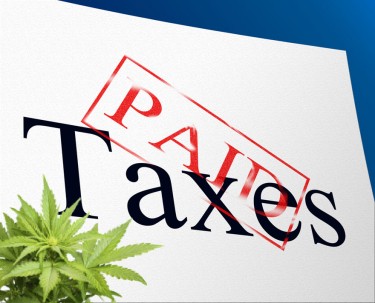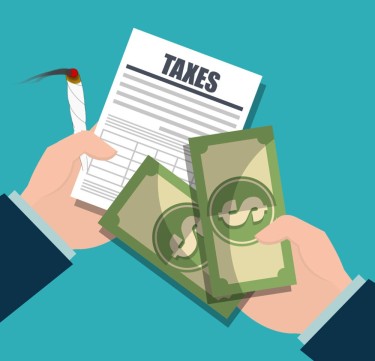
MJ BIZ reported recently that California state officials have stated that approximately 94% of cannabis excise taxes owed by marijuana firms have been paid. Still, they also recognized a fall in total sales and tax collections in 2022. Two primary taxes apply to the sale of cannabis in the state: the standard sales tax, which varies from 7.25% to 8.25% depending on the jurisdiction, and a special 15% excise tax on cannabis collected by sellers and paid to the state. As of May 16, the California Department of Tax and Fee Administration (CDTFA) reported that 94% of the excise taxes due had been paid. Cannabis sales subject to taxation were $5.38 billion in 2022, with $1.11 billion in total taxes owed. $278 million in unpaid state taxes, including past-due excise and sales taxes as well as unpaid cultivation taxes before their abolition last year, are still owing. These numbers do not reflect revenue that businesses have not yet recorded. Given that the state reported tax income of $1.3 billion based on 2021 sales of $5.781 billion, it is clear that cannabis sales and taxes will drop between 2021 and 2022. Nine marijuana-related companies have already requested payment arrangements to cover these unpaid taxes.
High Tax Payment Compliance Rate
The cannabis sector in California has been subject to a significant tax framework designed to raise money and control the market. The cannabis excise tax, which is imposed on the sale of cannabis products, is one of the state’s main sources of income. According to recent data, 94% of cannabis excise taxes are paid by registered businesses, which is a remarkable compliance rate.
Several variables contribute to the high compliance rate. First and foremost, the legalization of cannabis has significantly reduced the criminal market, encouraging consumers and companies to enter the legal market. Legal avenues encourage companies to conduct themselves legally, assuring the payment of taxes. Additionally, the state’s strict licensing and regulatory framework ensures that registered enterprises pay their taxes on time. Businesses are encouraged to maintain compliance because failure to do so may result in fines or cancellation of licenses.
The significant income collected through tax payments demonstrates the growing consumer and business acceptance of the legal cannabis sector. Additionally, it shows how effective California’s regulatory policies are at promoting a law-abiding and ethical industry.
Pricing Pressures: The Impact of Intense Competition on Sales Revenue
Intense competition within California’s legal cannabis industry has resulted in significant pricing pressures that directly affect sales revenue. With numerous licensed businesses operating in the market, saturation and fierce competition have led to price reductions as businesses vie for customers. While lower prices may attract consumers, they ultimately contribute to declining overall sales revenue for licensed cannabis businesses.
To remain competitive, licensed businesses use pricing strategies to undercut rivals. However, this race to the bottom erodes profit margins and makes it challenging to generate substantial revenue. Moreover, regulatory and tax burdens further exacerbate the pricing pressures faced by licensed cannabis businesses. Compliance with regulations and tax obligations adds to operational costs, making it difficult to maintain competitive pricing.
Mitigating the impact of pricing pressures requires licensed cannabis businesses to focus on differentiation and value-added offerings. Emphasizing unique products, premium quality, exceptional customer service, and innovative branding can create a competitive advantage beyond price. Policymakers and regulatory bodies should also consider ways to alleviate compliance costs and taxes, enabling businesses to maintain reasonable pricing while operating within the legal framework.
By adopting customer-centric strategies and standing out from the competition, licensed cannabis businesses can navigate pricing pressures, mitigate the impact on sales revenue, and position themselves for long-term success in the dynamic marketplace.
The Cost of Compliance for Cannabis Businesses
Complying with the complex regulatory framework is a costly endeavor for cannabis businesses in California. Packaging and labeling regulations require businesses to invest in redesigning packaging, procuring specialized materials, and printing equipment to meet the stringent requirements. Product testing to ensure safety and accurate potency labeling also involves substantial fees, adding to the financial burden. Licensing fees, renewed annually, further contribute to the overall cost of compliance.
Beyond the financial implications, the time and effort required to navigate the regulatory landscape pose significant challenges. Compliance with reporting requirements, record-keeping, and accurate inventory tracking demand dedicated personnel and robust systems. Failing to meet these obligations can lead to penalties, license suspensions, or revocations. These compliance costs and administrative burdens directly impact the profitability of cannabis businesses and their ability to generate substantial revenue.
To address these challenges, collaboration between policymakers, regulatory bodies, and cannabis businesses is crucial. Streamlining regulations, providing support mechanisms for small businesses, and balancing consumer safety and business viability are key. By creating a more manageable compliance landscape, California can foster an environment where cannabis businesses can thrive, leading to increased sales revenue and overall success in the legal cannabis industry.
The Battle Against Unlicensed Dispensaries
The illicit market remains a significant competitor to the legal cannabis industry in California, even after the state’s legalization efforts. Unlicensed dispensaries and unregulated products undermine the regulated market and impact the sales revenue of licensed businesses.
Price plays a crucial role in the illicit market’s appeal. Unlicensed dispensaries often offer cannabis products at lower prices compared to licensed establishments. This attracts price-conscious consumers who are seeking more affordable options. Licensed businesses, however, must comply with regulations and taxes, which can increase their production costs. The resulting price disparity disadvantages licensed businesses and can contribute to a decline in their sales revenue.
Safety is another concern with the illicit market. Unregulated products lack proper testing and quality control measures, potentially containing harmful contaminants or inaccurate potency levels. Some consumers are willing to purchase from unlicensed sources due to the allure of lower prices. This diversion of customers away from licensed businesses further impacts their sales revenue and undermines the state’s efforts to ensure consumer safety.
To combat illicit market competition, California has been intensifying enforcement efforts against unlicensed dispensaries and illegal cannabis operations. In coordination with regulatory bodies, law enforcement agencies conduct raids and shut down illicit operations. These measures aim to level the playing field for licensed businesses and increase consumer trust in the regulated market.
Promoting safety and quality and supporting legal businesses can help steer consumers away from the illicit market. In addition to enforcement, education, and awareness campaigns are crucial in informing consumers about the benefits of purchasing from licensed dispensaries. Promoting safety and quality and supporting legal businesses can help steer consumers away from the illicit market. By actively addressing the issue of illicit market competition, California can safeguard the integrity of its legal cannabis industry, bolster sales revenue for licensed businesses, and foster a safer and more sustainable cannabis market overall.
Bottom Line
California’s cannabis industry faces challenges such as pricing pressures, competition from the illicit market, and the high cost of compliance. While the compliance rate for cannabis excise taxes is commendable at 94%, declining sales and tax revenue indicate the impact of intense competition and market saturation. To overcome these challenges, policymakers should consider alleviating compliance costs, streamlining regulations, and supporting small businesses. By promoting differentiation, consumer trust, and a level playing field for licensed businesses, California can foster a thriving and sustainable cannabis industry that contributes to its economic growth.
CANNABIS TAXES FOR STATE REVENUE, READ ON..
HOW MUCH REVENUE CAN A STATE GET FROM CANANBIS TAXES?
- SEO Powered Content & PR Distribution. Get Amplified Today.
- EVM Finance. Unified Interface for Decentralized Finance. Access Here.
- Quantum Media Group. IR/PR Amplified. Access Here.
- PlatoAiStream. Web3 Data Intelligence. Knowledge Amplified. Access Here.
- Source: http://cannabis.net/blog/news/california-ramped-up-enforcement-on-unpaid-cannabis-taxes-now-reports-94-of-cannabis-excise-tax
- :has
- :is
- :not
- :where
- $UP
- 11
- 15%
- 16
- 2021
- 2022
- 7
- 8
- a
- ability
- About
- acceptance
- According
- accurate
- actively
- adding
- addition
- Additionally
- address
- addressing
- Adds
- administration
- administrative
- Adopting
- ADvantage
- affect
- affordable
- After
- against
- agencies
- aim
- alleviate
- allure
- already
- also
- an
- and
- Annually
- Another
- appeal
- Apply
- approximately
- ARE
- AS
- At
- attract
- Attracts
- awareness
- away
- balancing
- based
- Battle
- because
- been
- before
- benefits
- between
- Beyond
- Billion
- biz
- bodies
- bolster
- Bottom
- branding
- burden
- business
- businesses
- by
- california
- Campaigns
- CAN
- cannabis
- Cannabis Industry
- cannabis products
- challenges
- challenging
- clear
- collaboration
- collections
- combat
- comes
- commendable
- Companies
- compared
- competition
- competitive
- competitor
- complex
- compliance
- comply
- Concern
- Conduct
- Consider
- consumer
- Consumers
- contaminants
- contribute
- control
- coordination
- Cost
- costly
- Costs
- cover
- create
- Creating
- Criminal
- crucial
- cultivation
- customer
- Customer Service
- Customers
- data
- Decline
- Declining
- dedicated
- Demand
- demonstrates
- Department
- Depending
- designed
- difficult
- directly
- dispensaries
- Diversion
- do
- down
- Drop
- due
- dynamic
- Economic
- Economic growth
- Education
- Effective
- effort
- efforts
- emphasizing
- enabling
- encourage
- encouraged
- encouraging
- endeavor
- enforcement
- ensure
- ensures
- Enter
- enterprises
- Environment
- equipment
- ethical
- Even
- exceptional
- faced
- faces
- failing
- Failure
- Fall
- fee
- Fees
- field
- fierce
- financial
- fines
- firms
- First
- Focus
- For
- foremost
- Foster
- Framework
- from
- further
- generate
- get
- given
- Growing
- Growth
- had
- harmful
- Have
- help
- High
- How
- However
- HTTPS
- Illegal
- illicit
- Impact
- Impacts
- implications
- imposed
- in
- inaccurate
- Including
- Income
- Increase
- increased
- indicate
- industry
- innovative
- integrity
- intensifying
- inventory
- Invest
- involves
- issue
- IT
- ITS
- jpg
- jurisdiction
- Key
- labeling
- Lack
- landscape
- Last
- Last Year
- Law
- law enforcement
- lead
- leading
- Led
- Legal
- legal framework
- legalization
- legally
- Level
- levels
- License
- Licensed
- licenses
- Licensing
- long-term
- lower
- Main
- maintain
- MAKES
- Making
- margins
- marijuana
- Market
- marketplace
- materials
- May..
- measures
- mechanisms
- Meet
- million
- Mitigate
- money
- more
- Moreover
- much
- must
- Navigate
- now
- numbers
- numerous
- obligations
- of
- offer
- Offerings
- officials
- often
- on
- ONE
- operating
- operational
- Operations
- Options
- or
- out
- overall
- Overcome
- owed
- packaging
- paid
- Pay
- payment
- Personnel
- plato
- Plato Data Intelligence
- PlatoData
- playing
- plays
- policies
- policymakers
- position
- potency
- potentially
- price
- Prices
- pricing
- primary
- printing
- Product
- Product testing
- Production
- Products
- Profit
- profitability
- promoting
- proper
- providing
- purchase
- purchasing
- quality
- Race
- raise
- Rate
- Read
- reasonable
- recent
- recognized
- record-keeping
- recorded
- redesigning
- Reduced
- reductions
- reflect
- registered
- regulated
- regulations
- regulatory
- regulatory landscape
- remain
- remains
- remarkable
- renewed
- Reported
- Reporting
- Reports
- requested
- require
- required
- Requirements
- requires
- result
- resulted
- resulting
- revenue
- rivals
- robust
- Role
- s
- safer
- Safety
- sale
- sales
- sector
- seeking
- Sellers
- service
- should
- Shows
- Shut down
- significant
- significantly
- small
- small businesses
- So
- some
- Sources
- special
- specialized
- standard
- State
- stated
- Still
- strategies
- streamlining
- strict
- subject
- substantial
- success
- such
- support
- Supporting
- Suspensions
- sustainable
- Systems
- tax
- Taxes
- Testing
- that
- The
- The State
- their
- themselves
- These
- they
- this
- Thrive
- thriving
- Through
- time
- to
- Total
- Tracking
- Trust
- two
- Ultimately
- Undermine
- unique
- use
- variables
- viability
- ways
- WELL
- were
- which
- while
- WHO
- will
- willing
- with
- within
- year
- yet
- zephyrnet













